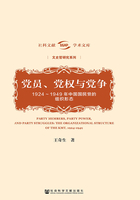
Abstract
Starting 1924 the Chinese Nationalist Party, or the Kuomintang(KMT), followed the example of the Communist Party of the Soviet Union(Bolshevik)in setting up its own organizational mechanisms, placing the Party above the state, subjecting the state to the rule of one single party. However, the political blueprint in the Three Principles of the People(Sanmin zhuyi)proposed by Sun Yat-sen was drawn up on the basis of Western democratic institutions. As such, the Nationalists in fact established a party apparatus that was made up of two mutually incompatible political frameworks. There were on one hand the five branches(Yu a n)-Executive,Legislative,Judicial, Examination, and Supervision, in accordance with the Western political theory of checks and balances. But on the other hand there were also a central executive committee and a central political council - a symbol of power centralization - as per the Soviet theory of party rule. In European democratic countries and the US, there were separate political bodies in charge of legislation, judiciary, and execution; whereas countries such as the Soviet Union in which the state is ruled by the party, there were only committees controlled by the single ruling Party. Yet the Chinese Nationalist Party tried to merge these two systems.
Suck an attempt proved to be fraught with serious flaws. On the one hand, the Nationalists' monopoly of the political power meant the plan for democratic constitutionalism(xianzheng)devised by Sun Yat-sen would fail eventually; on the other hand, the goal of democratic constitutionalism established in the Three Principles of the People put the KMT's one-party rule in an awkward situation, and was often singled out as a target of harsh criticism by those outside the regime who attacked this one-party rule.
Although the Nationalists intended to implement Soviet-style one-party rule, in practice, the party organization of the KMT, which was based on a Western parliamentary model, was too weak to centralize power. The KMT was, in fact, a fragile dictatorship. It was not that the Nationalists had no intention of establishing an authoritarian regime but they never acquired the power necessary to actually exercise dictatorship due to inadequate Party capabilities and inappropriate social conditions. Prior to the Chinese People's War of Resistance against Japanese Aggression(War of Resistance), the Nationalist government had controlled only 25 percent of the land and 66 percent of the population in China. Because of the KMT's inadequate capabilities, the local governments at the lowest level could do little to crack down on powerful and wealthy outlaws who wrecked havoc on the local community in its name. The mainstay of the KMT regime was not its Party members and Party apparatus, but soldiers and military forces. Among the three key components of the regime, namely the Party, the government, and the army, the Party was the most fragile. During both the War of Resistance and the subsequent Civil War in which it fought the Communists, the KMT organizations were always the fi rst to collapse, followed by the government, and finally the army. The reverse order would be followed when over the Nationalist regime was trying to take back a place: the army would arrive first, followed by the government and finally the party organizations. As for the Chinese Communist Party(CCP), the party organizations consisted of the political nucleus, whereas for the KMT they were reduced to a mere appendage to the government and the army. It was the army rather than the Party that Chiang Kai-shek relied most heavily on. Dominated by Chiang's principle of “army above Party”, the military power gradually increased, while the power of the Party declined. In both the center and local areas, military power trumped the Party and the government, and Party-rule was thus in name only. The KMT only maintained a nominal control of the government and the army; it was, instead, it was the army that exercised de facto control over the government and the Party.
After the CCP-KMT split, the KMT showed a complete disregard for the existence of class confl icts in China and claimed to represent the interests of all the people, something that in fact not exist. The KMT had attempted to establish its foundation on the alliance of different classes that had confl ict of interests among them. But in fact it failed to win the hearts and minds of any of them. None of the classes saw the KMT as truly representing their own interests. It followed that the KMT could claim no social class as its own foundation.